Samsung ATIV Tab Review: Qualcomm's First Windows RT Tablet
by Anand Lal Shimpi on January 3, 2013 6:00 AM EST- Posted in
- Tablets
- Samsung
- Qualcomm
- Mobile
- Windows RT
Performance
What makes the ATIV Tab most interesting is in its use of Qualcomm's APQ8060A SoC. With a pair of Krait CPU cores running at up to 1.5GHz, we should see tangibly better performance than the 1.3GHz Tegra 3 powered Surface RT.
As we make our way into 2013, at least on the Windows side of things, I'll be able to move away from js based performance comparisons between tablets. For now, we start off with some of the latest JavaScript tests we've been using in our mobile reviews. All of these were run in Modern IE10 on the Windows devices.
First up are the RIABench focus tests, these are javascript benchmarks that focus on various compute bound tasks. The Focus Tests are very short, with the entire benchmark completing in under 6 seconds for all of the participants here:
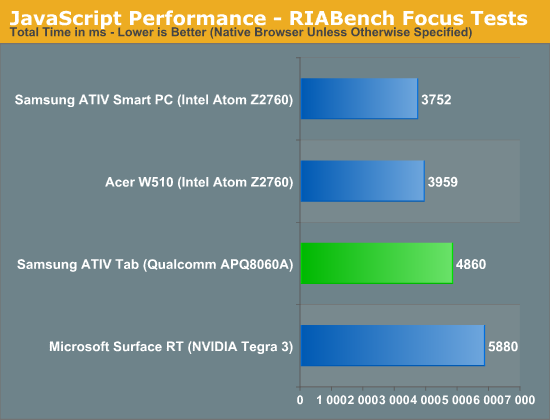
RIABench starts off as a teaser of what's to come: the APQ8060A is around 21% faster than NVIDIA's Tegra 3, but Intel's Atom Z2760 pulls ahead by nearly 30%.
Next up is SunSpider, a short to mid-length JavaScript benchmark that we've used for a while now:
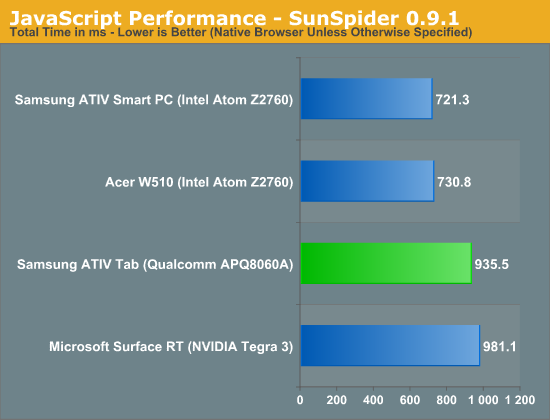
SunSpider shows a fairly close match between Qualcomm and NVIDIA, however once again Clover Trail is able to pull ahead by nearly 30%.
Finally we have Kraken, a seriously heavy javascript benchmark built by Mozilla. Kraken focuses on forward looking applications that are potentially too slow to run in modern browsers today. The result is much longer run times than anything we've seen thus far, and a very CPU heavy benchmark:
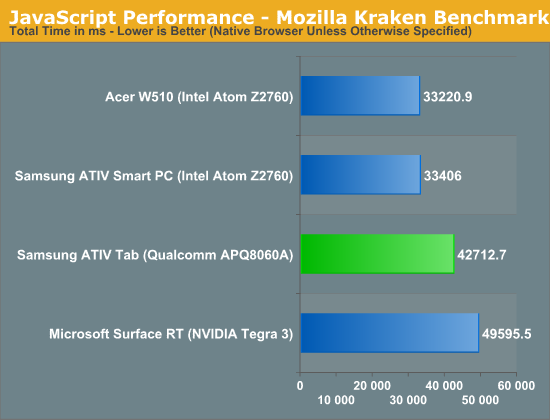
The Kraken results mimic RIABench: Qualcomm holds a 16% advantage over NVIDIA, while Intel manages a 28.5% advantage over Qualcomm.
We have one last web-based benchmark: WebXPRT by Principled Technologies (PT). WebXPRT measures performance in four HTML5/js workloads:
Photo Effects: Measures the time to apply effects to a set of six photos. The filters are Sharpen, Emboss, and Glow. WebXPRT applies each filter to two photos. This test uses HTML5 Canvas 2D and JavaScript.
Face Detect: Measures the average time to check for human faces in a photo. WebXPRT runs this test on five photos and uses the average time to calculate the final result. This test uses HTML5 Canvas 2D to get access to photo data. The detection algorithm is implemented in JavaScript.
Stocks Dashboard: Measures the time to calculate financial indicators of a stock based on historical data and display the result in a dashboard. The calculations are done in JavaScript, and the calculated stocks data is displayed using HTML tables and Canvas 2D.
Offline Notes: Measures the time to store notes securely in the browser's HTML5 local storage and display recent entries. This test uses using AES for security.
We're reporting the overall score after all tests have been run:
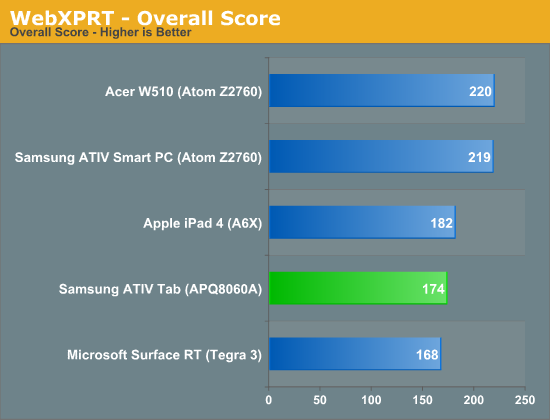
The WebXPRT tests show a narrower gap between Tegra 3 and APQ8060A, however the Intel advantage remains strong at 26%.
Next up are another set of benchmarks from PT, but unlike the WebXPRT suite these tests don't run in a browser. Once again we're looking at performance in a handful of tasks designed to stress the CPU:
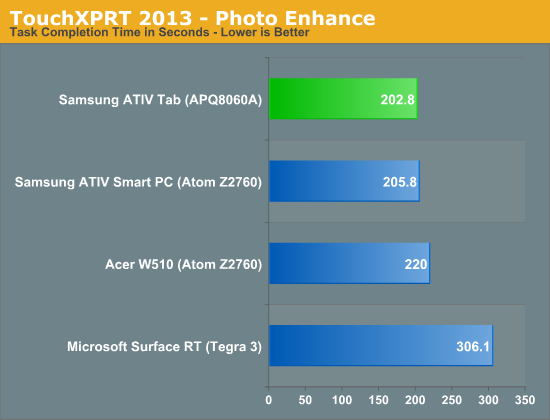
Now things are looking a bit different. Qualcomm is able to manage a slight victory over the Clover Trail equipped ATIV Smart PC. For all intents and purposes, APQ8060A equals the performance of Atom Z2760 in this test.
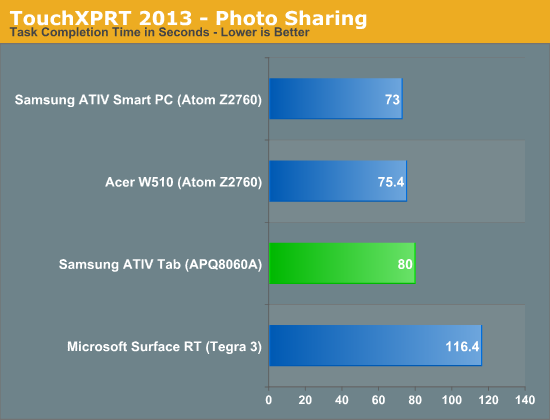
Intel pulls ahead a bit in the Photo Sharing benchmark, but Qualcomm remains quite competitive.
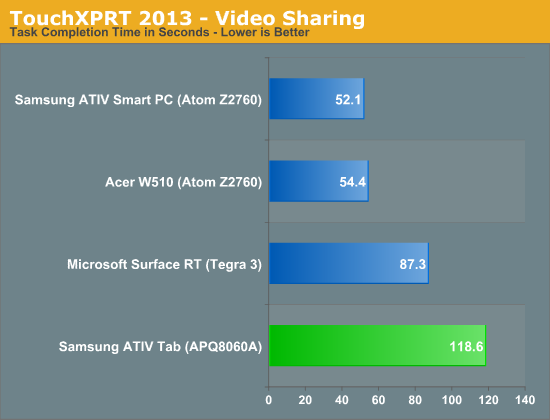
The one blemish on Qualcomm's TouchXPRT 2013 record is its performance in the video transcoding benchmark. Apparently this test sets up two decode streams (one for transcode and one for preview) and one encode stream, while Qualcomm's hardware decoder appears to be optimized for a single stream decode. The result is that both decode streams are interleaved, which increases the benchmark time. Qualcomm argues that for this type of a workload you'd typically setup a single decode stream and use that same stream for transcode and preview rather than setup two streams. Qualcomm was quick to point out that this isn't a Krait CPU limitation but rather a unique pairing of workload and decode hardware that resulted in the performance delta here.
Through the remaining two tests Qualcomm's performance remains close to Intel's:
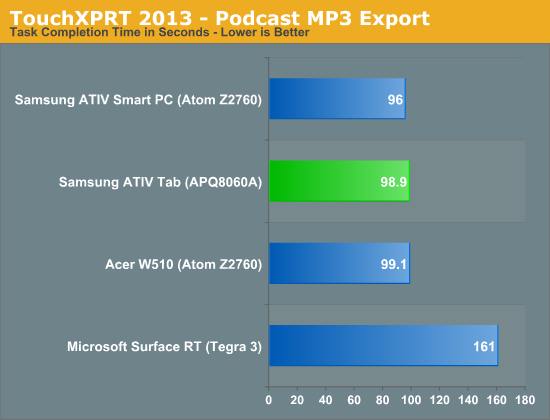
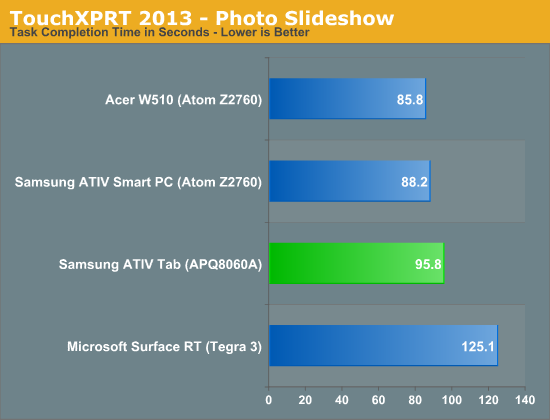
Intel manages an 11% performance advantage here, while Qualcomm's APQ8060A delivers a significant performance margin over Tegra 3.
In practice I'd say my experience with the ATIV Tab mirrored what these results showed. Qualcomm's superior single threaded performance resulted in a snappier desktop experience than what I got with Tegra 3 on Surface RT. In many cases, the ATIV Tab felt just as quick as Acer's Clover Trail based W510 although that wasn't always the case. UI performance in desktop mode was appreciably better than on the W510 however. Modern UI performance remains quick and smooth, as is the case with all Windows RT/8 tablets (Clover Trail does seem to get a slight edge here).
Although we don't yet have reliable 3D benchmarks we can run on Windows RT, from what I've seen it looks like the Adreno 225 hardware/driver implementation in Windows RT results in performance that's between Clover Trail and Tegra 3. Depending on the workload, I've even seen better performance out of APQ8060A/Adreno 225 than Tegra 3. It'll be a little while before we can fully quantify all of this though.


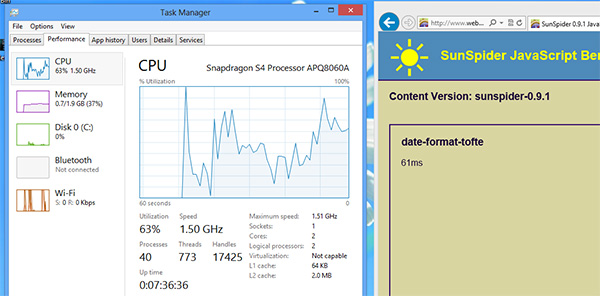








42 Comments
View All Comments
snoozemode - Thursday, January 3, 2013 - link
Lets hope that is the case. But if that is what Blue is, what about current Windows RT devices? And WP8 devices? Will they too be left in the cold as WP7.5 devices? For me it feels like Microsoft has created this massive pile of mess that I'm not sure how long it will take before it's sorted out. I mean my Windows 8 computer still has two separated Internet explorers that doesn't sync favorites between eachother, and this is in year 2013.Silent_Rage - Thursday, January 3, 2013 - link
The current RT and WP8 devices will be upgraded to Blue as well. I'm positive of this since Blue is a smaller form of an update as compared to the usual cycle we've seen with Windows in the past. Windows Blue will be the first "annual" update to Windows and we will see granular changes to Windows RT. On the backend, we will see a shift to align the two OSs (RT and WP8) to share the same APIs, more so than what we're seeing today.ninjacut - Thursday, January 3, 2013 - link
I actually prefer Microsoft approach of not using Phone OS on a tablet, firstly it simply becomes a more productive device and can handle content creation activity better than the Phone OS. Secondly, the way performance is improving in these SOC's the Phone OS will need to catch-up in features. This is already happening with Android doing multi-user and split screen like WRT and will continue to do so. Microsoft has a good advantage at this point.Regarding the 7inch form factor, WRT can perform well but certain features will make less sense such as the desktop. But its again advantage and not a disadvantage.
The challenge is to release WRT 7inch tablet, at the right price asap!
snoozemode - Friday, January 4, 2013 - link
My point is that the WRT UI could stay as it is, the OS would just change UI depending on screen size as Android did in ICS.Regarding desktop in WRT, can't really see the point of having it since you can't run any legacy programs anyway. It's basically there to run Office 2013. Make a Metro UI Office and remove Desktop.
Wolfpup - Thursday, January 3, 2013 - link
This sounds like a dumb question, but do Windows Phone 8 programs also run on Windows 8 and RT? P8 runs P7 stuff, and I've been assuming that RT and real Windows 8 can run Windows Phone 7 and 8 programs too, but not necessarily optimized for the display, iOS style...but I actually have no idea if that's the case.Also...I have no idea if it's even possible to back up metro programs. I'm not a huge fan of iOS, but one of the things it does right is let you back up programs to a PC, so you can manage them and don't have to redownload multiple GB onto a new device, or when you're juggling storage.
Really disapointed Metro isn't open though...otherwise Windows 8 is what I've wanted since before the original iPad-a real PC that has an optional tablet interface...but to be a real PC it has to be OPEN...ironically Android is open (technically), Windows 8 as a desktop OS is open, but metro isn't :(
damianrobertjones - Thursday, January 3, 2013 - link
1080p 'real' resolution on a device like this would feature text so small you wouldn't be able to read. Increase the DPI? Might as well just drop straight to 1366x768.Marketing.
DeciusStrabo - Friday, January 4, 2013 - link
Like Android Windows 8 is able to display Metro-Apps independently from the physical resolution, meaning they always use a logical resolution (which makes them look like Babbies first computer-Apps on my 27" screen, since all elements and letters are huge, not taking advantage of the space offered, simply making everything scale up.However the advantage is of course that this way they can use more pixels to display elements, making them look smoother (what Apple does with Retina, but more flexible as you aren't limited to multiples of their logical resolutions and the weird and resources intense offscreen rendering process).
So 1080p would be great to have on Windows RT/WP8 devices too, as it just means smoother and more readable UI elements, not smaller UI elements (disadvantage on desktops, advantage on mobile devices).
mayankleoboy1 - Thursday, January 3, 2013 - link
It has Adreno225.How about NOOOO
killerclick - Thursday, January 3, 2013 - link
Lol @ 1366x768Lol @ dead platform
Lol @ available storage
It's worth $350 at most (not even that if you don't need Office), although seeing how Metro devices are doing, they should be offering more for less.
BrokenCrayons - Thursday, January 3, 2013 - link
I'm not at all a huge fan of Windows RT devices since I just don't see the value added in limiting one's computing to a keyboard-less device or having to add a keyboard at additional cost to perform data entry at a reasonable speed, but tablets have their place as content consumption and entertainment devices. They're also the current wizbang thing to purchase, replacing other fads like 3D TV and netbooks.All that said, there's really nothing wrong with the screen's resolution given the 10 inch size. Yes, there's lots higher resolution devices available, but to make those devices usable, objects on screen must be scaled to a reasonable size, negating lots of the advantages while costing in battery life and platform performance managing pixels that are simply there to be checkbox specification for marketing.
The platform isn't dead yet. It might go the way of Windows Mobile someday, but it's sort of early to assume such is the case.
The device storage is pretty disappointing. Sure you can add memory via SD or an external devices, but it would be nice to be able to use more of what you're paying for OR for the cost of additional storage to be lower. One of the things that I don't care much for with RT (and 8-based tablets as well) is the large footprint of the OS. It hasn't gotten much worse since 7's launch, but the move from rotating hard disks to flash memory has certainly made getting lots of storage an expensive prospect. Power consumption and durability are nice, but vendors do make you pay if you want to keep much information on the device itself.